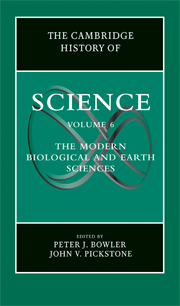Book contents
- Frontmatter
- 1 Introduction
- PART I WORKERS AND PLACES
- PART II ANALYSIS AND EXPERIMENTATION
- 10 Geology
- 11 Paleontology
- 12 Zoology
- 13 Botany
- 14 Evolution
- 15 Anatomy, Histology, and Cytology
- 16 Embryology
- 17 Microbiology
- 18 Physiology
- 19 Pathology
- PART III NEW OBJECTS AND IDEAS
- PART IV SCIENCE AND CULTURE
- Index
- References
12 - Zoology
from PART II - ANALYSIS AND EXPERIMENTATION
Published online by Cambridge University Press: 28 November 2009
- Frontmatter
- 1 Introduction
- PART I WORKERS AND PLACES
- PART II ANALYSIS AND EXPERIMENTATION
- 10 Geology
- 11 Paleontology
- 12 Zoology
- 13 Botany
- 14 Evolution
- 15 Anatomy, Histology, and Cytology
- 16 Embryology
- 17 Microbiology
- 18 Physiology
- 19 Pathology
- PART III NEW OBJECTS AND IDEAS
- PART IV SCIENCE AND CULTURE
- Index
- References
Summary
Zoology, the study of the animal kingdom, is no longer seen as a coherent branch of science. The specialization of the twentieth century has seen zoology’s territory divided among a host of separate disciplines. But in the nineteenth century that specialization was only beginning, and many naturalists would still have called themselves “zoologists,” their primary concern being to gain an understanding of the animal kingdom as a whole, its diversity of structure and function, and the ways in which its component species were related.
Exploration and the description of new species continued to drive home the sheer diversity of nature: Zoologists searched for the “natural system” of relationships but disagreed over how to uncover it. Philosophical naturalists started from a priori assumptions and abstract principles, searching for unity and symmetry in the array of natural forms. Many were influenced by various forms of idealist philosophy proclaiming that nature was the manifestation of a rational Mind. Others adopted a more empirical approach, starting from the study of particular cases; these naturalists were more likely to include information on the habits, distribution, and ecological relationships of species. There were constant disagreements over the relative significance of “form” (internal biological constraints) and “function” (adaptation to the environment) in determining the structure of individual species. The advent of evolutionism transformed biologists’ ideas on the nature of the relationships between species, although the theory’s impact on practice is less easy to define.
- Type
- Chapter
- Information
- The Cambridge History of Science , pp. 205 - 224Publisher: Cambridge University PressPrint publication year: 2009
References
- 1
- Cited by



